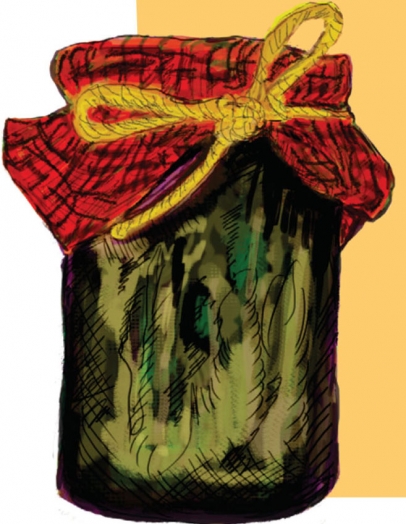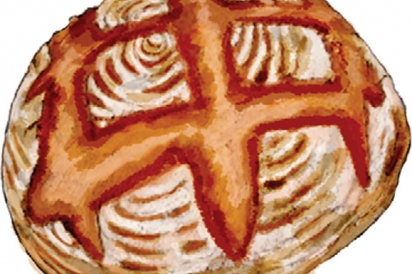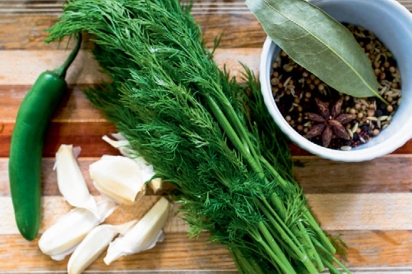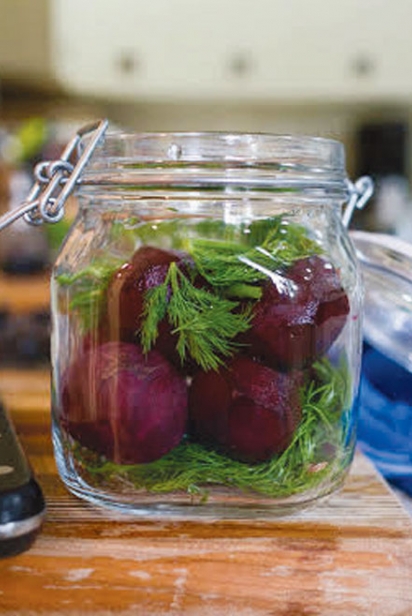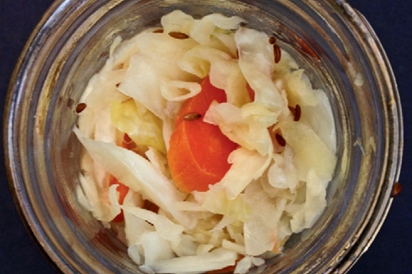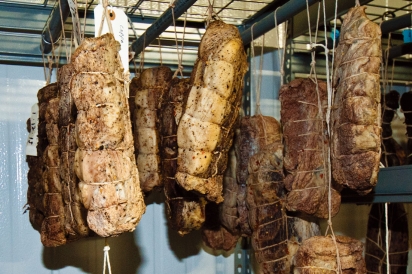Fun with Fermentation
Crazy about kimchi? Sweet on sourdough? Mad about miso? South Florida's fermenting community is bubbling up with enthusiasm about wild micro-organisms.
Fermentation combines science, history, art, even philosophy. Science defines the processes of transforming food by bacteria, yeasts and other microorganisms. Historically, people have turned to fermentation as a way of preserving foods and, of course, making them delicious. Art comes into play with creativity and experimentation such a vital part of making any fermented products, from a home cook’s backyard kraut to a vineyard’s finest wine.
And for the philosophy behind fermentation, Art Friedrich of Urban Oasis Project offers this analogy: “You’re not killing bad bacteria – they’re there, alive. You’re just trying to make sure the good bacteria are running the show. You create an environment where the good can survive. You focus energy on promoting the good. It’s a philosophical approach to life. Fermentation allows us to tap into ancient knowledge for preserving raw vegetables, grains and meats.”
Then there is, simply, the practical. Fermenting foods preserves the bounty, letting you enjoy March’s cucumbers and cabbage longer (and differently), turn fruit peelings into vinegar, share your sourdough with neighbors. In South Florida and beyond, there is a community of chefs, brewers, bakers, artisans and – especially – home cooks who find joy, comfort, fulfillment and health benefits in making fermented foods.
Consider the range of foods and drinks that are fermented. Beer and wine are obvious; other beverages include mead (made from honey); sake, kombucha, shrub, ginger beer and kvass. Coffee, cacao and vanilla undergo fermentation, and so do some tea leaves. Dairy products include yogurt, creme fraiche, buttermilk kefir and cheese. Fermentation turns vegetables into kimchi, kraut, sauerruben, pickles, salsas and relishes. It makes olives edible. Sourdough is a ferment; so are rice congee, poi and cassava breads. More familiar Asian fermented products are South Indian dosa and idli, miso, soy sauce and fish sauce. Fermented meats include brined corned beef and tongue and dry-cured sausages like salami and coppa.
Fermentation allows us to tap into ancient knowledge for preserving raw vegetables, graims amd meats.
- ART FRIEDRICH
EVERY CULTURE HAS A CULTURE
“Cultured food is a tradition in every culture,” says Friedrich. “Foods based on bacteria and yeast connect us with traditions. Bringing people closer to food is just as important as the nutritional value.”
Friedrich started his fermenting journey with kombucha in 2002. “I found it to be addictive,” he says. “We had kombucha mixed with cayenne, ginger, maple syrup, apple cider vinegar.” Six years later, he met self-described fermentation revivalist Sandor Katz, author of The Art of Fermentation and Wild Fermentation. “I was helping him in the kitchen to make food for 300 people, including a huge crock of fermented vegetables. You use what’s around, based on whatever’s in abundance.”
A bountiful harvest is one reason Friedrich turned to making his fermented vegetables. As a farmers market organizer, he had produce left over at the end of the day. Rather than adding it to the compost heap, he started preserving vegetables. Not every experiment worked; “when I tried to ferment bok choy, like cabbage, it was inedible - an utter failure,” he says. “I tried okra, and it was technically edible, but not palatable.” But sauerkraut (cabbage) and sauerruben (root vegetables) were successful. Today, you can find Friedrich’s sauerkraut and sauerruben line, called Art in Culture, at many South Florida farmers markets.
Friedrich offers these general directions for sauerkraut:
- Shred cabbage and mix it with good sea salt (not iodized, which is antibacterial) in a 10-gallon crock.
- For sauerruben, use peeled and grated turnips, beets, radishes or daikon, or a combination, mix with salt and place in the crock.
- Place a clean weight on top of the vegetables (a smaller lid, stones, untreated wood) and set aside. The salt will pull the water out of the vegetables.
- If after 12 hours the resulting liquid is not covering the vegetables, add more brine.
- Skim off the foam that will appear on top, and skim it again after 3-4 days, then a week.
- Make sure the brine doesn’t get too low.
- If you see mold, discard those pieces. “It can smell terrible, but the worse it smells, the better it tastes,” he says.
- How long it takes until it’s ready to eat depends on how much salt you use – less salt results in a faster ferment. Sauerkraut typically takes 10-12 days, and sauerruben three to five weeks. “At that point scoop off the top crud, put in clean jars, and label,” he advises.
- “Don’t seal it tightly – it keeps creating carbon dioxide and gets explosive.”
- Don’t can the jars by processing them with heat. “You are pasteurizing it and killing the live culture, and you want that great probiotic culture.”
- Above all, feel free to experiment. “It’s all about touching your food and playing with it,” Friedrich says.
SOURDOUGH: A RISING DOUGH LIFTS ALL LOAVES
Biting into a slice of rustic sourdough bread – chewy, tangy, moist, slightly sweet, richly textured – is so satisfying, it’s hard to imagine how bland, uniform supermarket loaves can even be called bread.
Instead of being leavened from commercial yeast, sourdough breads use a starter made from flour and water that catches the wild yeasts in the air. Zak Stern (Zak the Baker), whose rustic breads have defined South Florida’s artisanal bread scene, says sourdough adds a level of complexity to the bread that’s hard to match with conventional yeast. “If you share our goal in trying to extract the maximum amount of flavor from a minimum amount of ingredients, then you rely heavily on the fermentation process to transform the flattasting wheat flour into a sweet, pleasantly pungent, nutty, slightly acidic, creamy loaf of bread,” he says. “Commercial yeast certainly does simplify and speed up the process, but it’s just not the story I’m interested in telling. I would prefer to be a part of the ancient, the traditional, the complex, the natural, the wild fermentation.”
It was Stern’s loaves that inspired baker and chef Stefan Uch of Crackerman Crackers in Bay Harbor Islands to add sourdough to his offerings. The German-born chef, who also sells flax and sesame seed crackers, European specialty breads and seasonal loaves at farmers markets, says he didn’t do too much fermenting in Germany. “When I tried the first bread from Zak, I was blown away,” he says. So he developed his own variations, including cranberry with Georgia pecans, Kalamata olive sourdough and pumpernickel. The hearty loaves are delicious but come at a price: “They’re labor intensive. You have to handle it a lot. Nobody wants to do that” today, Uch says. But it is bread that’s beautiful in its simplicity – magnificent sourdough loaves emerging from nothing more than flour, water and a bit of salt.
Making sourdough begins with starter. The general process is straightforward: Make a smooth batter by mixing an ounce of flour (some say rye works fastest) and an ounce of water (unchlorinated) in a crock. Stir daily for a few days until bubbles form and there’s a yeasty smell. Throw out half of the bubbly starter and feed what’s left water and flour in equal parts, and repeat the discarding-and-feeding cycle daily for three to six days. What’s happening? The culture of microflora – friendly bacteria and wild yeast – “lives off sugars and poops carbon dioxide,” Uch explains. For each feeding, throw out half of the starter. This keeps the amounts
manageable and helps balance the pH. When your starter is ready - its aroma should be tangy, but not overwhelming - measure out what you need for your bread, and store the remaining starter in the refrigerator, feeding it flour and water weekly.
Starter can last for a long, long time. Uch has been using his starter for three years, while Stern created his “mother” in 2009 when he was working on a goat cheese farm in Israel. “It was only 200g at the time,” he says. “We’re close to 1,000 loaves per day, which uses roughly 75kg of mother, 517kg of flour, 850kg of dough, 10 hands to shape, 10 hours of baking, two delivery trucks, 24 hours a day!”
If you want to try making sourdough, Uch advises a visit to Grateful Bread in North Miami (gratefulbread.us) and thefreshloaf.com, a community for artisan bread enthusiasts. Find Crackerman artisan breads (crackermancrackers.com) at the Saturday farmers market at Legion Park on Biscayne and 66th St.
ADVENTURES IN PICKLING
Food writer and blogger David Rosendorf tried his hand at pickles.
Fermentation requires a suspension of disbelief of some of the basic principles you learn as a home cook. One thing ingrained into me early on was the “danger zone” – the food safety principle that bad bacteria multiply in the range of 40°F to 140°F, Keep it hot or cold, but not the in-between of room temperature.
So what am I doing leaving a jar of vegetables out on my countertop for a month?
Making good food, as it turns out. I’ve had mixed luck with fermented foods. My last batch of kimchi was great, but the one before that – well, we had to open the windows whenever I opened the jar.
This time, the inspiration came from Bar Tartine: Techniques & Recipes, a cookbook that serves as a sort of DIY manual for the San Francisco restaurant of the same name. Bar Tartine (a spin-off of the famous Tartine Bakery) is famous for doing everything in house, from scratch, including lots of fermented and preserved products. These are techniques that have been around for generations, and the book’s matter-of-fact tone made it sound easy. So why not?
I had beets and fresh dill from my CSA share, so I homed in on the brined beets recipe. I peeled the beets, made a brine (about 1 tablespoon kosher salt to 1 cup water) with a sort of slurry of serrano chile and garlic, added the dill and spices (coriander, caraway and mustard seeds, black peppercorns, star anise), and stuck it all in a couple glass jars. And then waited. For about a month.
I’d peek every couple days to make sure everything was submerged under the brine, release built up carbon dioxide, check for any mold (you can just sort of snip away any white surface mold), and give it a sniff test. Eventually the beets’ magenta hue pervaded everything in the jar, and the aroma was pleasantly sour and “pickly.” (My wary family grew tired of me going “Here, smell!”) After a month, I retrieved a few beets, sliced them, and plated them with some Greek yogurt, red vein sorrel from my garden, and a sprinkle of “everything spice” (check the Momofuku Milk Bar Cookbook for that recipe).
And? They were delicious. Maybe a little firmer than I’d hoped (they’re not cooked at all); but earthy, tart and redolent with the pickling spices. Plus: Everyone lived!
RECONNECTING WITH FAMILY AND HERITAGE
FOR MARIAN WERTALKA, RedlandRambles.com blog covers Bee Heaven Farm and other local organic farms, fermenting is a way to use the abundance of fresh produce in the weekly CSA share. It’s also turned out to be a way for her to recreate familiar childhood flavors from her Lithuanian family.
“When I was very young, my grandfather would make farmers cheese. He built his own cheese press out of wood, which had a pan underneath to catch the dripping whey. He also made sauerkraut, pickled beets and pickled cucumbers, which we ate at family meals,” she says. She decided to try her hand at sauerkraut, consulting Sandor Katz’s Wild Fermentation for guidance on the right amount of salt: 3 tablespoons salt to five pounds of cabbage. “A friend recommended getting a gallon jar with an airlock to prevent mold, and it worked great. Just pack it full, top off the brine, and let nature do its work. This latest batch of kraut pretty much kept its color and crunch, and after four weeks was nice and tangy. Plus, there was no mold. I repacked half into quart jars at that stage, and let the rest go a couple weeks longer. The six-week ferment looked a little less bright, the texture was softer, and it tasted tangier, more like what I was after. Now I have a new batch of kraut going, a mix of red and green cabbage seasoned with ginger and turmeric. It’s turned an amazing shade of magenta. Some ingredients for kimchi are loitering in my refrigerator – bok choy, da ikon, home-grown ginger, homemade sriracha.”
Wertalka says she’s learned to weigh and measure carefully, and make sure that there’s enough brine to cover everything. “Get a food scale, because a lot of recipes go by weight. And get lots of jars!”
PATIENCE, PRUDENCE: CURING MEATS
Unlike fresh sausages, which must be refrigerated and stay fresh for only a few days, fermented sausages - Spanish chorizo, French saucisson, Italian salami - rely on good bacteria to feed the sugar and generate lactic acid. This keeps the meat from spoiling and adds a tanginess to the whatever flavors are added to the meat. Dry curing is also used to make prosciutto, coppa, bresaola and lardo. These are the most prized items on the charcuterie plate, but they are also tricky because they depend on humidity and atmospheric conditions. Consistency is a constant challenge.
To make dry-cured meats, salt is used to reduce bacteria that would cause the meat to spoil. Nitrites prevent botulism. Meats are dried in a cool, dark place where the humidity is controlled – too low, and the casings dry out too quickly, preventing inner moisture from getting out.
Andres Barrientos and James Bowers of Miami Smokers (see story, page 20) are among but a few businesses making cured meats in South Florida. To make their salami, they start with Berkshire pork butts, spices and flavorings, curing salt plus live starter culture and dextrose, the sugar to feed the bacteria. This is ground, like sausage, and placed in casings: sheep for thin sausages like meat sticks; hog for medium sausages and chorizo; and beef casings for large salamis, like sopressata. The salamis are trussed to support them as they dry. They are first placed in the smoker, where the temperature is warmer, to incubate the bacteria, causing them to produce more lactic acid and begin curing. They’re then hung in the cave-like cooler room, kept at about 55 degrees and 70 percent humidity. As the casing starts to dry, the inside color of the sausage changes to dark red as the pH changes. Mold may start to develop on the outside, and depending on its color, it’s not a bad thing. “What you’re watching for is the type of mold,” says Bowers. Dry white mold is considered good because it forms a protective layer. “Green/blue or fuzzy, like the kind you see on cheese, should be wiped off with vinegar and salt. Black mold can be toxic – throw it away.”
As the moisture leaves the sausages, flavors intensify and texture improves. But because the process itself takes time – at least two months, and as long as four months or even more – it’s hard to know whether you’ve found the right balance. “The first batch we made, we followed a traditional ratio of 70 percent meat to 30 percent fat. We gave it to friends, who said it was too fatty. So we went to 80/20,” he says. The constant adjusting process, to get the best flavor and consistency, continues indefinitely, and is one of the challenges faced by artisan sausage-makers.
FROM BREWS TO TOMICS: HONEY FERMENTS
Talk about a long shelf life. Honey remains have been found in ancient vessels in Georgia dating back 5,000 years and in Egyptian tombs. Honey keeps so well because its low moisture content and acidic nature makes it too hard for bacteria and other organisms to survive. Keep your honey jar sealed and it won’t go bad. So how can fermentation even occur?
“You have to add something to it – water or fruits and vegetables,” says Tom Wilfong, an IT specialist at Miami-Dade County Public Schools whose website, http://fermentthis.com, explores his experiences with fermenting. His interest in fermentation started with brewing beer. During a bout with gout, he discovered kombucha to control it. “That was a turning point for me.” He started experimenting with kimchi, making it as a Valentine’s Day gift for his wife, Vanessa, but it was impossible to keep it a secret: “The whole house smelled.” Next, he turned to mead - wine made from honey – and honey ferments, syrups using fruits and vegetables. “Basic mead is honey plus water plus yeast, three pints water to one pint honey. It takes about a month until it’s fully fermented.
It tastes like a fruity to dry white wine,” he says. You can flavor them after or during fermentation. Wilfong entered his hibiscus mead, using wild yeast in the air, that won top honors in a local homebrewers competition.
Honey tonics, he explains, use wild yeasts that come from the fruits or vegetables to create a tasty syrup with no alcohol flavor. “We have a honey-garlic-turmeric ferment that wards off colds,” he says. “I’ve done honey-blackberry and honey-blueberry. It’s a really short ferment that pulls water out of fruit, no need to add yeast.” To make an easy honey tonic, find a mason jar with a tight-fitting lid with 1 to 1% cups raw honey and a half cup of berries, rinsed, “but not superclean - you don’t want to wash off the wild yeasts.” Close the jar, shake it up. The next morning, “burp” the jar – open it to release pressure caused by the fermentation – and close it again. Repeat “burping” twice a day. In five days, it should be ready to use as pancake syrup or to flavor kombucha, for example. Wilfong suggests experimenting. He’s tried honey with jalapeno, with ginger and with carrots.
FAQ ON FERMENTATION
WHAT DOES IT MEAN? Foodsthat have been fermented are transformed in flavor and texture by enzymes produced by bacteria, microbes or yeast. Lactofermentation – preserving food using live bacterial cultures - is used to preserve fruits and vegetables, condiments, tonic beverages and dairy products. Culturing usually requires a microbial starter-yeast, some yogurt, whey, “mother” or SCOBY (symbiotic communities of bacteria and yeast).
I THOUGHT ONLY WINE, BEER AMD YOGURT WERE FERMENTED. Many foods involve fermentation! They include cider, chocolate, coffee, sauerkraut, miso, bread, cheeses, pickles, salami, vinegar, kombucha and kefir. Favorite ethnic foods are also fermented, like Korean kimchi, Japanese miso and natto, Indian idli and dosa,Vietnamese nam pla (fish sauce), Indonesian tempeh and Jewish sour pickles, to name only a few.
ARE FERMENTED FOODS HEALTHIER? Many think so. They are probiotic – alive with good organisms can help you maintain a healthy gut. Bacteria “predigest” parts of the food, making it easier for your body to absorb nutrients. Of course, some fermented foods are high in sodium.
IS FERMEMTLMG SAFE? Yes, if you do your research, take basic precautions and follow food safety rules. Observe rules of cleanliness. For vegetables, use the right kinds of salt (iodized salt can inhibit fermentation) follow instructions for temperatures in fermenting. Fermenting has been around for thousands of years, long before modern ways of preserving foods existed, like refrigeration, canning, pasteurizing, and processing by adding preservatives and chemicals.
CAN’T I JUST BUY MY OWN PICKLES AT THE SUPERMARKET? sure, but don’t count on getting the benefits of live culture. Most fermented foods sold in cans or jars have been pasteurized, killing friendly bacteria. When you make your own kimchi or sauerkraut, for example, it will continue fermenting slowly in your refrigerator. Pickling or canning processes using a hot water bath are a way to preserve vegetables, but because the heat kills the bacteria, these aren’t ferments.
WHERE DO I START? Get a copy of Wild Fermentation or The Art of Fermentation by Sandor Ellix Katz, considered the bibles of fermentation. Check out the South Florida fermenting community (see page 27). They’re an invaluable source of information.
FIND OUT MORE
At most farmers markets, you’ll find someone who can talk about fermenting and answer questions. Turn to page 40 for a list of markets. Other online sources include:
• Wild Fermentation group on Facebook
• localfoodsouthflorida.org and look on “Fermenting Culture Share”
• fermentthis.com, Wilfong’s website
Verde Farm is planning upcoming fermentation workshops. Visit ediblesouthflorida.com and click on “Resources.


